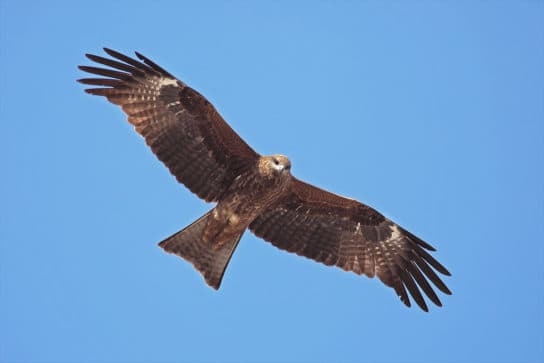Black kite (lat.Milvus migrans) represents the order of falconifers and belongs to the hawk family. This bird of prey is distinguished by its heat-loving nature, so it spends winter in warm regions.
Appearance
The size of the black kite ranges from 40 to 60 centimeters in length with a body weight of 800 to 1200 grams. In terms of its dimensions, it is not inferior to crows. Large wings, which are the same in size as the whole body, with a span of up to one and a half meters, give this species massiveness. The plumage color is predominantly dark brown, which appears black in the distance. The head area has a grayish tint and contrasts slightly with the color of the entire plumage. Juveniles may be lighter in color. The legs are rather weak and short.

Black kite in flight
The black kite is distinguished by its expressive appearance. Due to its eye structure, it often looks aggressive. You can distinguish a black kite even at a great distance. The most important characteristic feature is the forked tail, which is on the same plane with the wings during flight. The tail performs the steering function in flight. You can also identify a kite by its characteristic sound, which resembles a trill.
Habitat
The black kite is a fairly numerous species with a wide habitat. It has spread to Africa, Madagascar, Asia, many island regions, New Guinea and Northern Australia. The black kite is found in Russia and Ukraine. Prefers to settle in forest-steppes, rich in rivers. These birds can often be found in floodplains of rivers and lakes. The nesting sites can live even in large cities. In the summer, they prefer to arrange nests in the branches of tall trees.

Nutrition
The black kite is a typical predator that has good hunting skills. However, due to its resourcefulness, it can trace food sources for people and animals. There were kites that hunted down fishermen, who brought them to fishing grounds. Having found a place with a sufficient amount of food, black kites are in no hurry to hunt, they prefer to wait until they have something left.
Black kites can feed on various carrion and garbage. Typically, the largest percentage of their diet consists of this. Birds prefer not to hunt large mammals, because, due to weak limbs, they may not be able to cope with prey. The only victim that they can easily pick up with their feet is small fish.

The main animals that make up the diet of the black kite are rodents, fish, amphibians, lizards, insects, worms and crustaceans. Most often, their prey lives in rivers or near them. For this reason, they prefer to inhabit areas with water bodies, since it is easier for them to hunt and get food there. Black kites prefer to hunt killed animals, since they will need a minimum amount of effort to capture them.
Nesting
The breeding period of black kites is marked with the arrival of spring. At this time, the birds return to their territory after wintering. Arrangement of nests takes place on trees at a height of about 10 meters. The most remote forest areas are chosen so that the nests are inconspicuous. Some individuals can nest on rocks. The size of the nest can be up to a meter in diameter. Birds prefer to nest in the same nests until they are completely unusable. Every year the birds are busy improving their nests. Various rags, garbage, branches and everything that can be found nearby are used as materials.

Offspring
The incubation period lasts about 4 weeks. One clutch contains 2-4 eggs in a white shell and brown specks. Only the female is engaged in incubation. At this time, the male is actively searching for prey. Females are extremely careful during the incubation period. If strangers appear, they can hide in nests or hover in advance at a short distance from a potential enemy. When the female realizes that her nest is in danger, she begins to attack. She dives menacingly and can jump with claws on her face.
Birds that live near cities can attack people for no particular reason. Such aggressive black kites live in India and Africa, in Russian latitudes they are calmer.
The chicks that have been born are brown or red in color. Young animals behave aggressively in the nests. Chicks can fight each other, which sometimes leads to the death of one of the chicks. At the age of 5 weeks, young kites leave the nest and make attempts to make their first flight. By the age of three months, they become as large as adult birds. Departure to warm places begins in August and lasts until the end of autumn.

Black kite chicks
Lifestyle
Black kites differ from many birds in that they often form colonies. They tend to soar for a long time without making any flaps of their wings. Most of the time, they float calmly in the air. Some birds can climb to very great heights that they can hardly be seen. The rest of the time is devoted to the search for easy prey.
It is common for these birds to decorate the place of their nests. In this way, they show their strength to other birds. In turn, the birds that noticed this can arrange skirmishes with the black kite. Weak and sick birds prefer not to use any additional elements in the arrangement of the nest, so as not to provoke other birds to fight.
